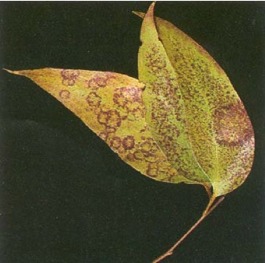PESTS AND DISEASES OF FORESTRY IN NEW ZEALAND
Phaeothyriolum Leaf Spot of Eucalyptus
4. Phaeothyriolum Leaf Spot of Eucalyptus,
Forest Pathology in New Zealand No. 1.
Compiled: 1983, minor update 1990, revised 2009
Fungus: Phaeothyriolum microthyriodes (G. Winter) H.J. Swart
Note: Previously known as Microthyrium eucalypti
Type of injury
Leaves become disfigured but tree growth is not usually affected. However, rare heavy infestations may cause premature leaf drop or reduce photosynthesis.

Fig. 4 - Phaeothyriolum microthyriodes on Eucalyptus fastigata .
Diagnostic features
Minute, black fruiting bodies, resembling iron filings, arranged in a circular or semi-circular pattern on both upper and lower leaf surfaces. Affected leaves may turn a pale green colour or develop purple blotches.
Hosts
Corymbia ficifolia, C. maculata, Eucalyptus botryoides, E. delegatensis, E. fastigata, E. fraxinoides, E. johnstonii, E. nitens, E. quadrangulata, E. regnans.
Distribution
Throughout New Zealand.
Disease development
The shield-shaped fruiting bodies are entirely superficial. When mature, a circular opening is formed in the centre of these fruiting bodies for the release of the spores, which are then dispersed by wind. Infection most commonly occurs in the lower crown on mature foliage.
Economic importance
Not considered of any significance.
Control
Not considered necessary.
Bibliography
Dick, M. 1982: Leaf-inhabiting fungi of eucalypts in New Zealand. New Zealand Journal of Forestry Science 12: 525-537.
Dick, M.; Gadgil, P.D. 1983: Eucalyptus leaf spots. New Zealand Forest Service, Forest Pathology in New Zealand No.1.
Gadgil, P.D. 2005: Fungi on trees and shrubs in New Zealand. Fungi of New Zealand Volume 4. Fungal Diversity Research Series 16: 1-437
Ridley, G.S.; Dick, M.A. 2001: An introduction to the diseases of forest and amenity trees in New Zealand. Bulletin 220. 110p

 Farm Forestry New Zealand
Farm Forestry New Zealand

